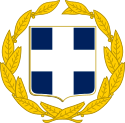Hellenic Air Force
The Hellenic Air Force (HAF; Greek: Πολεμική Αεροπορία, Polemikí Aeroporía, literally "War Aviation", sometimes abbreviated as ΠΑ) is the air force of Greece (with Hellenic being a synonym for Greek). The mission of the Hellenic Air Force is to guard and protect Greek airspace, provide air assistance and support to the Hellenic Army and the Hellenic Navy, as well as the provision of humanitarian aid in Greece and around the world. The Hellenic Air Force includes approximately 33,000 active troops, of whom 11,750 are career officers, 14,000 are professional conscripts (ΕΠ.ΟΠ.), 7,250 are volunteer conscripts and 1,100 are women. During the period of monarchy between 1935–1973 the force was known as the Royal Hellenic Air Force (RHAF) (Greek: Ἑλληνικὴ Βασιλικὴ Ἀεροπορία, Ellinikí Vasilikí Aeroporía). The motto of the Hellenic Air Force is the ancient Greek phrase Αἰὲν Ὑψικρατεῖν (Aièn Hypsikrateîn, "Always Dominate the Heights"), and the HAF ensign represents a flying eagle in front of the Hellenic Air Force roundel. The Hellenic Air Force is one of the three branches of the Hellenic Armed Forces.
History
The Hellenic Army traces its origin to the regular units established by the Greek provisional government during the Greek War of Independence (1821–1829). The first of these, an infantry regiment and a small artillery battery, were established in April 1822, and were commanded by European Philhellenes. Lack of funds however forced its disbandment soon after, and it was not until July 1824 that regular units were reformed, under the Greek Colonel Panagiotis Rodios. In May 1825, the first law on conscription was passed, and the command of the entire regular forces entrusted to the French Colonel Charles Fabvier. Under Fabvier, the regular corps expanded, and for the first time came to include cavalry, military music detachments, and, with Lord Byron's aid, military hospitals. The governorship of Ioannis Kapodistrias (1828–1831) saw a drastic reorganization of the national military: a Secretariat on Army and Naval Affairs and the Hellenic Army Academy were created, the Army engineering corps was founded (28 July 1829), and a concerted effort was made to reform the various irregular forces into regular light infantry battalions. Throughout these early years, French influence pervaded the Greek regular army, in tactics as well as appearance, as most of the instructors were French–at first Philhellenes, and later serving officers of General Maison's Expeditionary Corps.[3]
After Kapodistrias' assassination in 1831 and in the subsequent internal turmoil over the next two years, however, the regular army all but ceased to exist. The first king of the newly independent Greek kingdom, the Bavarian prince Otto, initially relied on a 4,000-strong German contingent. The royal government re-established the regular army and dissolved the irregular forces that had largely fought the War of Independence.[4] Following the ousting of Otto in 1862, the Army continued relying on the Army Organization Statute of 1833. The first major reforms were undertaken in 1877, in response to the Balkan Crisis that eventually led to the Russo-Turkish War of 1877–1878. Among other measures, for the first time the Hellenic Army was briefly subdivided into divisions and brigades. Universal conscription was introduced in 1879, and under the premiership of Charilaos Trikoupis, in 1882–1885 major steps were undertaken to improve the training and education of the officer corps: a French military mission was called to Greece, new schools were founded and Greek officers were sent abroad for studies, and efforts were made to make officers on active service refrain from participating in politics and focus on their professional duties. The Army also underwent its first mobilizations, in July 1880 – April 1882 due to the Greek annexation of Thessaly, and again in September 1885 – May 1886, when Bulgaria annexed Eastern Rumelia. The great financial burden of these long periods of mobilization, however, exhausted the public treasury, and stalled the reform process.[5][6] The result was that the Hellenic Army was wholly unprepared for war on the outbreak of the Greco-Turkish War of 1897: plans, fortifications and weapons were non-existent, the mass of the officer corps was unsuited to its tasks, and training was inadequate. As a result, the numerically superior, better organized, equipped and led Ottoman forces pushed the Greek forces south out of Thessaly.[7][8]
Balkan Wars and aftermath
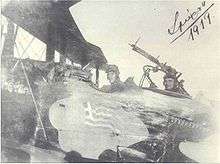
On October 5, 1912, Kamberos flew the first combat mission, a reconnaissance flight over Thessaly.This was the first day of the Balkan wars, and during the same day a similar mission was flown by German mercenaries in Ottoman service in the Thrace front against the Bulgarians.The Greek and the Ottoman mission flown during the same day are the first military aviation combat missions in a conventional war.As a matter of fact all Balkan countries used military aircraft and foreign mercenaries during the Balkan Wars. January 24, 1913 saw the first naval co-operation war mission worldwide, which took place above the Dardanelles. Aided by the destroyer Velos, first Lieutenant Michael Moutoussis and Ensign Aristeidis Moraitinis flew the Maurice Farman hydroplane and drew up a diagram of the positions of the Turkish fleet, against which they dropped four bombs. This was not the first air-to-surface bombing in military history as there was a precedent in the Turkish Italian war of 1911, but the first recorded attack against ships from the air.
Initially, the Hellenic Army and the Royal Hellenic Navy operated separate Army Aviation and Naval Aviation units. During the Balkan Wars, various French Henry and Maurice Farman aircraft types were in use. Naval Aviation was officially founded in 1914 by the then CinC of the Hellenic Navy, British Admiral Mark Kerr. Greek aviation units participated in World War I and the Asia Minor Campaign, equipped by the Allies with a variety of French and British designs.
In 1930, the Aviation Ministry was founded, establishing the Air Force as the third branch of the Armed Forces. The Hellenic Army Air Service and Hellenic Naval Air Service were amalgamated into a single service, the Hellenic Air Force. In 1931 the Hellenic Air Force Academy, the Scholi Ikaron (Σχολή Ικάρων), was founded.
In 1939, an order for 24 Marcel Bloch MB.151 fighter aircraft was placed, but only 9 of the aircraft reached Greece, since the outbreak of World War II prevented the French from completing the order. The aircraft served in the 24th Pursuit Squadron (MD – Moira Dioxis) of the then Hellenic Royal Air Force.
World War II and Civil War

During the Second World War, although being severely outnumbered, counting only 79 aircraft against the 380 fighters and bombers available to the Italian Regia Aeronautica,[9] RHAF managed to successfully resist the Italian invasion in 1940. On November 2, 1940, a Breguet 19 intercepted the 3 Alpine Division Julia while it was penetrating Pindos mountain range and moving on to occupy Metsovo. At the same day, Second Lieutenant Marinos Mitralexis, being out of ammunition, aimed the nose of his PZL P.24 (his aircraft imaged below from the paragraph title in mobile version) right into an enemy Cant Z1007bis tail, smashing the rudder and sending the bomber out of control.[10] However, after 65 days of war, the RHAF had lost 31 officers killed and seven wounded, plus four NCOs killed and five wounded. Meanwhile, the number of combat aircraft had dropped to 28 fighters and seven battleworthy bombers. [11] Still, in March 1941 the Italian invasion was confronted successfully. During the Greco-Italian War the Hellenic Air Force shot down 64 enemy aircraft (confirmed) and claimed another 24. Actually, according to other sources, Italians lost 65 aircraft during the whole campaign, against Greeks and British, getting 495 more aircraft damaged.[12] In April 1941 the German Wehrmacht invaded Greece to assist her Italian allies. The Luftwaffe destroyed almost the entire Hellenic Air Force; some aircraft managed to escape in the Middle East. The top ace of Hellenic Air Force was Andreas Antoniou with 5.5 victories.[10]
_Squadron_RAF_Hurricane_pilots_Egypt_WWII_IWM_CM_3362.jpg)
Five Avro Anson, one Dornier Do 22 and three Avro 626 escaped. Hellenic aviation was rebuilt under the Air Force Ministry based in Cairo. Three Hellenic squadrons were built, which were operating under the command of the British RAF. These squadrons were the 13th Light Bombing Squadron, with Avro Ansons, Bristol Blenheims and Martin Baltimores, and the 335 and 336 Fighting Squadrons, with Hawker Hurricane I and IIs and Spitfire V types. The Hellenic Squadrons in the Middle East took over a variety of missions, such as convoy patrols, antisubmarine search, offensive patrols, reconnaissance, attacks and interceptions of enemy aircraft. In summer 1943 the Greek Squadrons participated in the attack against the German Wehrmacht on the island of Crete. From May to November 1944 the Greek squadrons continued in Italy. Greek pilots operated with great success. Two of those pilots were Pilot Officer G. Tsotsos and Master Sergeant D. Soufrillas flying Spitfires credited with shooting down German Junkers 88 bombers. Seventy men were lost.[13]
During World War II Greek pilots who were flying with the RAF achieved many victories. Rhodesian-born Wing Commander John Agorastos Plagis shot down 16 enemy aircraft over Malta and Western Europe. Flying Lieutenant Vasilios Michael Vassiliadis was credited with 11.5 enemy aircraft over Western Europe before he was killed in action on March 15, 1945 over Germany. Steve Pisanos, an immigrant to USA in 1938, joined an Eagle Squadron of American volunteers in the RAF and fought over Western Europe. He later joined the USAF and took US citizenship to continue fighting with the same squadron, now part of the USAF 4th FG. He achieved 10 victories with USAF by 1944.
After Greece's liberation in 1944, RHAF returned home and subsequently played a decisive role in the Greek Civil War, which lasted until 1949, re-equipped with Supermarine Spitfire Mk IX, Spitfire Mk XVI fighters and Curtiss SB2C Helldiver bombers.
Post-war developments
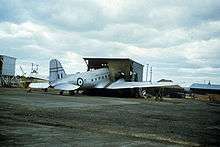
After the end of the Greek Civil War in November 1950, Greece sent seven Douglas C-47 Dakota transport aircraft of the 13th Transport Aircraft Squadron to South Korea to assist the United Nations. Greek aircraft operated in Korea until May 1955. Greek pilots flew thousands of war missions, including air evacuations, personnel transport, intelligence gathering, and supply flights.
In 1952 Greece was admitted to NATO and the Air Force was rebuilt and organized according to NATO standards, with US assistance. New aircraft, including jets, were introduced.
The first jet fighter flown by the Hellenic Air Force was the Republic F-84G Thunderjet. It was also flown by the first Hellenic aerobatic team, 337 SQ. Later, the F-84 replaced by the Canadair Sabre 2. About 100 examples were supplied during 1954 and 1955 after upgrading in the United Kingdom following service with the Royal Canadian Air Force. Lockheed T-33s were delivered to training units and some RT-33s were used for reconnaissance missions.
The Republic F-84F Thunderstreak first flew with the Hellenic Air Force in 1955. The RF-84F remained in service with the 348 Tactical Reconnaissance Squadron from 1956 to March 29, 1991.
In the late 1960s, the RHAF acquired new jet aircraft. These included the Lockheed F-104G Starfighter, the Convair F-102 Delta Dagger (in service 1969–1975) and the Northrop F-5 Freedom Fighter. The F-104 and F-5 served well for almost 20 years.
In the mid-1970s the Hellenic Air Force was further modernized with deliveries of the Dassault Mirage F1CG fleet, Vought A-7Hs (including a number of TA-7Hs) and the first batch of McDonnell-Douglas F-4E Phantom IIs, upgraded versions of which still serve today.
Also in 1993, the United States Air Force delivered 62 A-7Es and TA-7Cs, increasing the air-to-ground capability of the HAF. Some A-7s were still in service as of 2011, pending delivery of more-modern fighters.[14]
World War II
The country joined WWII with the Allies side in October 1940, when dictator Ioannis Metaxas rejected an Italian ultimatum by Mussolini. In the Greco-Italian War, the Hellenic Army pushed back the Italian and occupied large parts of Northern Epirus, but after a German invasion (Battle of Greece) fell under the Axis domination.
The exiled Greek government, with units of the Army, were transferred to Middle East, where they continued the war with the Allies.
Leo Niehorster's website shows the higher organisation of the Greek Army on 15 August 1940, with the General Staff of the Army directly supervising five corps, three divisions, and the Thessaloniki Fortress.[15]
After the war, Greece incorporated Dodecanese. Soon the political polarization between leftist/communist and anticommunist forces led to a civil war, which ended with communist defeat.
In total, the Hellenic Army has taken part in the following engagements:
- Greek War of Independence (1821–1830)
- Greco-Turkish War of 1897
- First Balkan War (1912–1913)
- Second Balkan War (1913)
- First World War
- Occupation of Northern Epirus (1914–1917)
- Macedonian Front of World War I (1916–1918)
- Allied intervention in the Russian Civil War (1919)
- Greco-Turkish War of 1919–1922
- Second World War
- Greco-Italian War (1940–1941)
- German invasion and Battle of Crete (1941)
- North African Campaign (1941–1943)
- Italian Campaign (1944)
- Greek Civil War (1946–1949)
- Korean War (1950–1953)
- Turkish Invasion of Cyprus (1974)
- Kosovo (1999–present)
- War in Afghanistan (2001–2012)
- War on Terrorism (2001–present)
Personnel
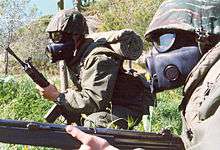
There are three classes of personnel in the Hellenic Army, namely professional, volunteer and conscript. There are currently 90,000 personnel on active duty, of which 30,000 are conscripted. As of 2012, the Hellenic Republic has mandatory military service (conscription) of 9 months for all males between the ages of 18 and 45. Citizens discharged from active service are normally placed in the Reserve and are subject to periodic recall of 1–10 days at irregular intervals. Greek males between the age of 18 and 60 who live in strategically sensitive areas may also be required to serve part-time in the National Guard. During a mobilization the amount of conscripts may exceed 180,000.[16]
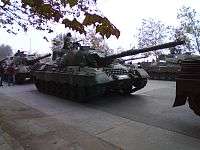
Conscript enlisted men and non-commissioned officers wear special rank insignia to differentiate them from volunteers.
Most professional officers graduate from the Evelpidon Military Academy in Athens (Στρατιωτική Σχολή Ευελπίδων) and the Corps Officers Military Academy in Thessaloniki (Στρατιωτική Σχολή Αξιωματικών Σωμάτων), while the rest graduate from various Military Schools according to their specialization.
In the chain of command, graduates of the two military academies in Athens and Thessaloniki are considered higher in seniority compared to professional officers of the same rank who graduate from specialized military schools. The latter officers are followed in seniority by volunteer and finally conscript staff.
During war, the Hellenic army battalions are commanded by either a ranking officer major general or if in a combat mission by another state which in agreement with the Greek state will be commanded by a ranking General of their own.
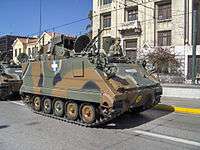
Commissioned officers
| Officer grade structure of the Hellenic Army | |||||||||||
|---|---|---|---|---|---|---|---|---|---|---|---|
| NATO Code | OF-9 | OF-8 | OF-7 | OF-6 | OF-5 | OF-4 | OF-3 | OF-2 | OF-1 | OF(D) | |
| Insignia |  |
 |
 |
 |
 |
 |
 |
 |
 |
 |
 |
| Title | Stratigos | Antistratigos | Ypostratigos | Taxiarchos | Syntagmatarchis | Antisyntagmatarhis | Tagmatarhis | Loxagos | Ypoloxagos | Anthypoloxagos | Dokimos Efedros Axiomatikos |
| Greek | Στρατηγός | Αντιστράτηγος | Υποστράτηγος | Ταξίαρχος | Συνταγματάρχης | Αντισυνταγματάρχης | Ταγματάρχης | Λοχαγός | Υπολοχαγός | Ανθυπολοχαγός | Δόκιμος Έφεδρος Αξιωματικός |
| Equivalent title | General | Lieutenant General | Major General | Brigadier | Colonel | Lieutenant Colonel | Major | Captain | Lieutenant | Second Lieutenant | Officer Designate |
NCO/Enlisted
| NCO – Enlisted grade structure of the Hellenic Army | |||||||||||||||
|---|---|---|---|---|---|---|---|---|---|---|---|---|---|---|---|
| NATO Code | OR-9 | OR-8 | OR-7 | OR-6 | OR-4 | OR-3 | OR-1 | ||||||||
| Insignia |  |
 |  |
 |  |
 |  |  |
 |  |  |
 | No insignia | ||
| Title | Anthypaspistis | Archilochias | Epilochias | Lochias | Dekaneas | Ypodekaneas | Ypopsifios Efedros Bathmoforos | Stratiotis | |||||||
| Greek | Ανθυπασπιστής | Αρχιλοχίας | Επιλοχίας | Λοχίας | Δεκανέας | Υποδεκανέας | Υποψήφιος Έφεδρος Βαθμοφόρος | Στρατιώτης | |||||||
| Equivalent rank |
Warrant Officer | Master Sergeant | Staff Sergeant | Sergeant | Corporal | Lance Corporal | Candidate Reservist Rank | Private | |||||||
Decade of wars: 1912–1922

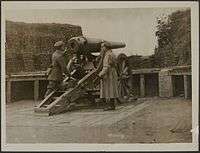
The dismal performance of the Hellenic Army in the war of 1897 led to a major reform programme under the administration of Georgios Theotokis (1899–1901, 1903–1904 and 1906–1909). A new Army Organization Statute was issued in 1904 (revised in 1910), purchases of new artillery material (including the 75 mm Schneider-Danglis 06/09 gun) and of the Mannlicher–Schönauer rifle were made, and a new, khaki field uniform was introduced in 1908.[17][18] Reform was accelerated after the Goudi coup of 1909.
The new government under Eleftherios Venizelos brought a French military mission to train the Hellenic Army. Under its supervision, the Greeks had adopted the triangular infantry division as their main formation, but more importantly, the overhaul of the mobilization system allowed the country to field and equip a far greater number of troops than it had in 1897: while foreign observers estimated a mobilized force of approximately 50,000 men, the Army eventually fielded 125,000, with another 140,000 in the National Guard and reserves.[19][20]
After the victorious Balkan Wars, the country doubled its territory. During the WWI, a disagreement between King Constantine and Prime Minister Eleftherios Venizelos caused a National Schism, but eventually a united Greece joined in 1917 the Allies.
As a winner of the war, Greece annexed Western Thrace and landed units in 1919 at Asia Minor, starting so the Greco-Turkish War (1919-22), but was defeated in 1922.
Personnel

There are three classes of personnel in the Hellenic Army, namely professional, volunteer and conscript. There are currently 90,000 personnel on active duty, of which 30,000 are conscripted. As of 2012, the Hellenic Republic has mandatory military service (conscription) of 9 months for all males between the ages of 18 and 45. Citizens discharged from active service are normally placed in the Reserve and are subject to periodic recall of 1–10 days at irregular intervals. Greek males between the age of 18 and 60 who live in strategically sensitive areas may also be required to serve part-time in the National Guard. During a mobilization the amount of conscripts may exceed 180,000.[16]

Conscript enlisted men and non-commissioned officers wear special rank insignia to differentiate them from volunteers.
Most professional officers graduate from the Evelpidon Military Academy in Athens (Στρατιωτική Σχολή Ευελπίδων) and the Corps Officers Military Academy in Thessaloniki (Στρατιωτική Σχολή Αξιωματικών Σωμάτων), while the rest graduate from various Military Schools according to their specialization.
In the chain of command, graduates of the two military academies in Athens and Thessaloniki are considered higher in seniority compared to professional officers of the same rank who graduate from specialized military schools. The latter officers are followed in seniority by volunteer and finally conscript staff.
During war, the Hellenic army battalions are commanded by either a ranking officer major general or if in a combat mission by another state which in agreement with the Greek state will be commanded by a ranking General of their own.

Commissioned officers
| Officer grade structure of the Hellenic Army | |||||||||||
|---|---|---|---|---|---|---|---|---|---|---|---|
| NATO Code | OF-9 | OF-8 | OF-7 | OF-6 | OF-5 | OF-4 | OF-3 | OF-2 | OF-1 | OF(D) | |
| Insignia |  |
 |
 |
 |
 |
 |
 |
 |
 |
 |
 |
| Title | Stratigos | Antistratigos | Ypostratigos | Taxiarchos | Syntagmatarchis | Antisyntagmatarhis | Tagmatarhis | Loxagos | Ypoloxagos | Anthypoloxagos | Dokimos Efedros Axiomatikos |
| Greek | Στρατηγός | Αντιστράτηγος | Υποστράτηγος | Ταξίαρχος | Συνταγματάρχης | Αντισυνταγματάρχης | Ταγματάρχης | Λοχαγός | Υπολοχαγός | Ανθυπολοχαγός | Δόκιμος Έφεδρος Αξιωματικός |
| Equivalent title | General | Lieutenant General | Major General | Brigadier | Colonel | Lieutenant Colonel | Major | Captain | Lieutenant | Second Lieutenant | Officer Designate |
NCO/Enlisted
| NCO – Enlisted grade structure of the Hellenic Army | |||||||||||||||
|---|---|---|---|---|---|---|---|---|---|---|---|---|---|---|---|
| NATO Code | OR-9 | OR-8 | OR-7 | OR-6 | OR-4 | OR-3 | OR-1 | ||||||||
| Insignia |  |
 |  |
 |  |
 |  |  |
 |  |  |
 | No insignia | ||
| Title | Anthypaspistis | Archilochias | Epilochias | Lochias | Dekaneas | Ypodekaneas | Ypopsifios Efedros Bathmoforos | Stratiotis | |||||||
| Greek | Ανθυπασπιστής | Αρχιλοχίας | Επιλοχίας | Λοχίας | Δεκανέας | Υποδεκανέας | Υποψήφιος Έφεδρος Βαθμοφόρος | Στρατιώτης | |||||||
| Equivalent rank |
Warrant Officer | Master Sergeant | Staff Sergeant | Sergeant | Corporal | Lance Corporal | Candidate Reservist Rank | Private | |||||||
Organisation
Personnel
Commissioned officers
| Officer grade structure of the Hellenic Air Force | ||||||||||
|---|---|---|---|---|---|---|---|---|---|---|
| NATO Code | OF-9 | OF-8 | OF-7 | OF-6 | OF-5 | OF-4 | OF-3 | OF-2 | OF-1 | |
| Insignia |  |
 |
 |
 |
 |
 |
 |
 |
 |
 |
| Title | Pterarchos | Antipterarchos | Ypopterarchos | Taxiarchos | Sminarchos | Antisminarchos | Episminagos | Sminagos | Yposminagos | Anthyposminagos |
| Greek | Πτέραρχος | Αντιπτέραρχος | Υποπτέραρχος | Ταξίαρχος | Σμήναρχος | Αντισμήναρχος | Επισμηναγός | Σμηναγός | Υποσμηναγός | Ανθυποσμηναγός |
| Equivalent title | Air Chief Marshal | Air Marshal | Air Vice-Marshal | Air Commodore | Group Captain | Wing Commander | Squadron Leader | Flight Lieutenant | Flying Officer | Pilot Officer |
NCO/Enlisted
| NCO – Enlisted grade structure of the Hellenic Air Force | |||||||||||||
|---|---|---|---|---|---|---|---|---|---|---|---|---|---|
| NATO Code | OR-9 | OR-8 | OR-7 | OR-6 | OR-5 | OR-4 | OR-1 | ||||||
| Insignia[21] |  |
 |  |
 |  |
 |  |
 |
 |
No insignia | |||
| Title | Anthypaspistis | Archisminias SMY | Archisminias EMTH-ΜΕΕ-EPOP |
Episminias SMY | Episminias EMTH-EPOP |
Sminias SMY | Sminias EMTH-EPOP |
Klirotos Sminias |
Yposminias EPOP |
Sminitis EPOP |
Sminitis | ||
| Greek | Ανθυπασπιστής | Αρχισμηνίας ΣΜΥ | Αρχισμηνίας ΕΜΘ-ΜΕΕ-ΕΠΟΠ |
Επισμηνίας ΣΜΥ | Επισμηνίας ΕΜΘ-ΕΠΟΠ |
Σμηνίας ΣΜΥ |
Σμηνίας ΕΜΘ-ΕΠΟΠ | Κληρωτός Σμηνίας |
Υποσμηνίας ΕΠΟΠ |
Σμηνίτης ΕΠΟΠ |
Σμηνίτης | ||
| Equivalent rank |
Warrant Officer | Chief Master Sergeant | Master Sergeant | Staff Sergeant | Conscirpt Sergeant | Corporal | Aircraftman | ||||||
Equipment
According to Hellenic Ministry of National Defence the HAF operates a total of 440+ aircraft of all types. Following the retirement of the A-7 Corsair and RF-4E Phantom II fleet, HAF currently operates 233 modern combat aircraft with 199 being fourth-generation fighters. Numbers in service are drawn from references [22] and are valid as of December 2015.[23]
Current inventory
.jpg)
%2C_Luxembourg_PP1209838195.jpg)
.jpg)
Retired
Previous aircraft operated were the Supermarine Spitfire, F-86 Sabres, Douglas C-47 Skytrain, Grumman HU-16 Albatross, Sikorsky H-19, Bell 47, Dassault Mirage F1, Lockheed T-33, Republic F-84F, Convair F-102 Delta Dagger, Lockheed F-104 Starfighter, Northrop F-5, A-7 Corsair II,RF-4E, and theDornier Do-28d2 Skyservant[27][28][29]
Weapons inventory
Air-to-air missiles:
- AIM-9M Sidewinder: 165
- AIM-9L/I1 Sidewinder: 300
- AIM-9L/I Sidewinder: 400
- AIM-9P4 Sidewinder (upgraded P3 and J-Sidewinder): 1,000
- AIM-120C-5/7 AMRAAM: 280
- AIM-120B AMRAAM: 240[30]
- IRIS-T: 350 (with 90 joint helmet mounted cueing systems)
- R550 Magic-2: 300
- MBDA MICA: 300
Air-to-ground munitions:
- Exocet AM-39 Block 2: 36
- SCALP EG: 90
- Bombkapsel 90 AFDS: 70
- AGM-65G2: 200
- AGM-65A/B: 200+ (?)
- AGM-88B Block IIIA: 84
- AGM-154C JSOW: 40
- GBU-8B HOBOS: 96
- GBU-12 & GBU-16 Paveway II: 1,162
- GBU-24 Paveway III: 200
- GBU-27 Paveway III: 250
- JDAM: 100
- Enhanced Paveway II: 50
Navigation and targeting pods
- DB-110: 2 (RECON)
- LANTIRN-AWNP (F-16 Block 50D & 52+): 23
- LANTIRN-TP (F-16 Block 50D & 52+): 23
- LITENING targeting pod F-4E AUP: 15
- A-7E/TA-7C LANA Night Navigation Pods: ?
- ASTAC ELINT-SIGINT: 4 ( RF-4)
Anti-aircraft systems
- Patriot PAC II/ PAC III AA missile system: 6 Batterries / 36 launchers / 325 missiles (as of 2004 installed near Athens, Thessaloniki on the island of Skyros and at Chrysoupoli in Northern Greece [31])
- S-300 PMU1 AA missile system: 1 Battalion/4 batteries/16 launchers/75 missiles(installed on the island of Crete)
- SKYGUARD/VELOS AA system: 20 launchers / 280 missiles / 24 Oerlikon-35 Guns
- Crotale NG/GR AA missile system: 9 launchers
- TOR M1 AA missile system: 4 launchers
- Stinger portable AA missile: unknown number of launchers / 300 missiles
- Artemis 30 30 mm AA guns: 38
- Rheinmetall 202 Mk20 : 326
Aircraft markings and camouflage
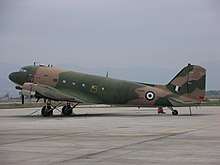
The primary camouflage scheme utilized by the Hellenic Air Force is the Aegean Ghost (Greek: Φάντασμα του Αιγαίου) scheme. This is modified slightly for each aircraft type but is standard for all combat and transport aircraft in the inventory. Some training, search-and-rescue, and firefighting aircraft are colored partially or completely in high-visibility colors for identification and easier location in case of an accident. The air force also frequently uses colorful commemorative schemes to mark anniversaries and other special occasions or for display purposes. National markings are applied to all aircraft, with the national roundel consisting of concentric blue, white, and blue rings displayed on the fuselage sides and wing surfaces and a tricolor fin flash of similar blue, white, and blue horizontal stripes on the rudder. The words Πολεμική Αεροπορία (or simply the abbreviation ΠΑ) are applied to the fuselage as well, although this is less common in current schemes. Aircraft in Aegean Ghost scheme may have low visibility markings applied in which blue is replaced by dark grey and white by light grey.
Originally, many aircraft in service retained the basic color scheme they were acquired in. Prior to World War II, combat aircraft were given a green and brown top scheme with white or sky blue underside, similar to the Royal Air Force. After the war, jet fighter aircraft such as the Sabre and Starfighter would serve in a polished metal scheme. Later, most aircraft received green and brown camouflage again, consistent with the United States Air Force's South East Asia scheme, referred to as Vietnam camouflage in Greece. A-7 Corsair IIs would be some of the last aircraft to fly with this scheme, retaining it until their retirement, long after all-over grey schemes had become the normal application for Greek aircraft. C-130 Hercules transports which used South East Asia early in their careers were repainted in an overall grey theme.
Aircraft accidents and incidents
The worst accident in the history of the Hellenic Air Force occurred on February 5, 1991 when Lockheed C-130H Hercules s/n 748 crashed into Mount Othrys during the landing approach to Nea Anchialos. Sixty-three people were killed.
Gallery
 Aviator Aristeidis Moraitinis, 1917
Aviator Aristeidis Moraitinis, 1917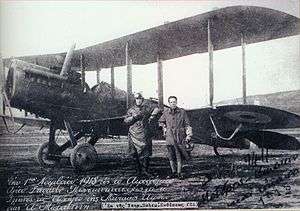 Greek aviators at the San Stefano airfield after the Armistice of Mudros, 1918
Greek aviators at the San Stefano airfield after the Armistice of Mudros, 1918 RHAF Canadair Sabre 2 in 1955.
RHAF Canadair Sabre 2 in 1955.- Pilot uniform of the 1960s
 A Hellenic Air Force f-104 Starfighter (Tanagra Military Airport).
A Hellenic Air Force f-104 Starfighter (Tanagra Military Airport). A Hellenic Air Force Dassault Mirage F1CG displayed at the 2008 HAF air show, Tanagra airbase, Greece.
A Hellenic Air Force Dassault Mirage F1CG displayed at the 2008 HAF air show, Tanagra airbase, Greece.- Cessna T-41D Mescalero of 360 squadron used by the Hellenic Air Force Academy.
.jpg) C-130H Hercules tactical transport aircraft of 356 squadron.
C-130H Hercules tactical transport aircraft of 356 squadron. CL-415 water bomber of 383 squadron.
CL-415 water bomber of 383 squadron. T-2E Buckeye jet trainer of 120 Wing.
T-2E Buckeye jet trainer of 120 Wing. AS.332 Super Puma of the Hellenic Air Force, operated for Search and Rescue (SAR).
AS.332 Super Puma of the Hellenic Air Force, operated for Search and Rescue (SAR). A Mirage 2000BGM of the Hellenic Air Force immediately after take off.
A Mirage 2000BGM of the Hellenic Air Force immediately after take off.
%2C_Luxembourg_PP1198066163.jpg) C-27J Spartan of the 354 Squadron "Pegasus". HAF operates 8 of those aircraft.
C-27J Spartan of the 354 Squadron "Pegasus". HAF operates 8 of those aircraft.
See also
References
- ↑ "Hellenic Air Force/History". Haf.gr. Archived from the original on July 18, 2009. Retrieved July 29, 2009.
- ↑ As a separate service. Army Aviation established in 1911
- ↑ Οι πρώτες προσπάθειες οργάνωσης τακτικού Στρατού (1821-1831) [The first efforts towards organizing a regular Army (1821-1831)] (PDF) (in Greek). Hellenic Army General Staff. Retrieved 18 April 2012.
- ↑ Ο Στρατός επί της βασιλείας του Όθωνα (1833-1863) [The Army during the reign of Otto (1833-1863)] (PDF) (in Greek). Hellenic Army General Staff. Retrieved 18 April 2012.
- ↑ Ο Ελληνικός Στρατός από το 1864 μέχρι τον Ελληνοτουρκικό Πόλεμο του 1897 [The Hellenic Army from 1864 until the Greco-Turkish War of 1897] (PDF) (in Greek). Hellenic Army General Staff. Retrieved 18 April 2012.
- ↑ Tsoukalas, Konstantinos (1977). "Η ανορθωτική προσπάθεια του Χαριλάου Τρικούπη 1882-1895" [The recovery effort of Charilaos Trikoupis 1882-1895]. Ιστορία του Ελληνικού Έθνους, Τόμος ΙΔ′: Νεώτερος Ελληνισμός από το 1881 ως το 1913 [History of the Greek Nation, Volume XIV: Modern Hellenism from 1881 to 1913] (in Greek). Ekdotiki Athinon. pp. 8–87.
- ↑ Erickson (2003), pp. 14–15
- ↑ Pikros, Ioannis (1977). "Ο Ελληνοτουρκικός Πόλεμος του 1897" [The Greco-Turkish War of 1897]. Ιστορία του Ελληνικού Έθνους, Τόμος ΙΔ′: Νεώτερος Ελληνισμός από το 1881 ως το 1913 [History of the Greek Nation, Volume XIV: Modern Hellenism from 1881 to 1913] (in Greek). Ekdotiki Athinon. pp. 125–160.
- ↑ Piekalkiewicz, Janusz; Van Heurck, Jan (1985). The air war, 1939-1945. Blandford Press. ISBN 978-0-918678-05-8.
- 1 2 "Hellenic Air Force History – Greco-Italian War ... German Invasion;—". www.haf.gr. Archived from the original on December 12, 2008. Retrieved February 6, 2010.
- ↑ Carr, John (2012). On Spartan Wings. Barnsley, SY, Pens & Sword Military. p. 45. ISBN 978-1-84884-798-9.
- ↑ Carr, John (2012). On Spartan Wings. Barnsley, SY, Pens & Sword Military. p. 171. ISBN 978-1-84884-798-9.
- ↑ "Hellenic Air Force History – Middle East;—". www.haf.gr. Retrieved February 6, 2010.
- ↑ "335 Μοίρα Βομβαρδισμού;—". www.haf.gr. Retrieved February 12, 2010.
- ↑ Niehorster, Dr. Leo. "Hellenic Army, 15 August 1940". niehorster.org.
- 1 2 http://www.armedforces.co.uk/Europeandefence/edcountries/countrygreece.htm#Greek Army
- ↑ Η αναδιοργάνωση του Στρατού μετά το 1897 και η μεγάλη εθνική εξόρμηση 1912-13 [The reorganization of the Army after 1897 and the great national assault 1912-13] (PDF) (in Greek). Hellenic Army General Staff. Retrieved 18 April 2012.
- ↑ Oikonomou, Nikolaos (1977). "Η αναδιοργάνωση του στρατού από την κυβέρνηση Θεοτόκη" [Reorganization of the army by the Theotokis government]. Ιστορία του Ελληνικού Έθνους, Τόμος ΙΔ′: Νεώτερος Ελληνισμός από το 1881 ως το 1913 [History of the Greek Nation, Volume XIV: Modern Hellenism from 1881 to 1913] (in Greek). Ekdotiki Athinon. pp. 186–192.
- ↑ Erickson (2003), p. 70
- ↑ Fotakis (2005), p. 42
- ↑ "Hellenic Airforce Ranks". Retrieved January 8, 2018.
- ↑ World Air Forces 2014 December 10, 2013
- ↑ "World Air Forces 2013". Flightglobal.com, December 11, 2012.
- 1 2 3 4 5 6 7 8 9 10 11 12 13 14 "World Air Forces 2018". Flightglobal Insight. 2018. Retrieved 4 December 2017.
- 1 2 "Greece buys Tecnam trainers". Air International. Vol. 95 no. 1. July 2018. p. 19. ISSN 0306-5634.
- ↑ "UAV MALE Πήγασος ΙΙ. To ελληνικό μη επανδρωμένο αεροσκάφος είναι έτοιμο και επιχειρησιακό!". March 27, 2013. Retrieved January 8, 2018.
- ↑ "WAF 1955". flightglobal.com. Retrieved 12 December 2017.
- ↑ "WAF 1971". flightglobal.com. Retrieved 12 December 2017.
- ↑ "WAF 1975". flightglobal.com. Retrieved 12 December 2017.
- ↑ "ΑΜΥΝΑ & ΔΙΠΛΩΜΑΤΙΑ 14. Όπλα & συστήματα μαχητικών αεροσκαφών". Amynanet.gr. Archived from the original on June 29, 2007. Retrieved July 29, 2009.
- ↑ "Athens installs Patriot missiles". July 27, 2004. Retrieved January 8, 2018 – via news.bbc.co.uk.
Further reading
- George J. Beldecos et al. Hellenic Wings: An Illustrated History of the Hellenic Air Force and its Precursors - 1908-1944, pub. Air Historical Branch (HAF), 1st edition (1999)
- A. Tsagaratos (Editor): Hellenic Air Force Yearbook 2010/B, Special Projects, Athens, Greece, ISSN 1790-4102 (2011). Page 8 contains a summary Order of Battle and a summary aircraft inventory, as of December 2010.
- Carr, John On Spartan Wings, Barnsley, SY, Pens & Sword Military, 2012. ISBN 978-1-84884-798-9.
- "World Military Aircraft Inventory", Aerospace Source Book 2007, Aviation Week & Space Technology, January 15, 2007
- The Library of Congress Country Studies, CIA World Factbook
- Greece – The Hellenic Air Force
- E. A. Pagotsis (2008). Hellenic Defence Review 2008–2009. Athens: Line Defence Public Ltd. pp. 128–159. External link in
|publisher=(help) - Aircraft Inventory (Greek)
Bibliography
- Carr, John, On Spartan Wings, Barnsley, SY: Pens & Sword Military, 2012. ISBN 978-1-84884-798-9.
External links
| Wikimedia Commons has media related to Hellenic Air Force. |



